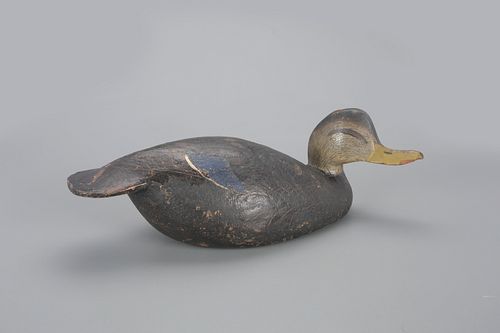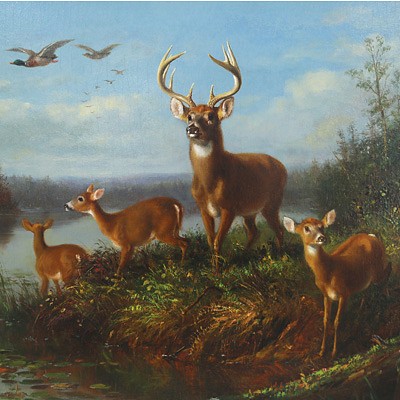Early Humpback Black Duck Decoy by The Ward Brothers
Lot 164
About Seller
Copley Fine Art Auctions
20 Winter Street
Pembroke, MA 02359
United States
Founded in 2005, Copley Fine Art Auctions is a boutique auction house specializing in antique decoys and American, sporting, and wildlife paintings. Over the course of the last two decades, the firm has set auction records for not only individual decoy makers, but also entire carving regions. Copley...Read more
Estimate:
$70,000 - $90,000
Absentee vs Live bid
Two ways to bid:
- Leave a max absentee bid and the platform will bid on your behalf up to your maximum bid during the live auction.
- Bid live during the auction and your bids will be submitted real-time to the auctioneer.
Bid Increments
| Price | Bid Increment |
|---|---|
| $0 | $50 |
| $1,000 | $100 |
| $2,500 | $250 |
| $5,000 | $500 |
| $10,000 | $1,000 |
| $25,000 | $2,500 |
| $50,000 | $5,000 |
About Auction
By Copley Fine Art Auctions
Feb 24, 2023
Set Reminder
2023-02-24 10:00:00
2023-02-24 10:00:00
America/New_York
Bidsquare
Bidsquare : The Winter Sale 2023, Day 1
https://www.bidsquare.com/auctions/copley/the-winter-sale-2023-day-1-11939
Lots 1-337 Copley Fine Art Auctions cinnie@copleyart.com
Lots 1-337 Copley Fine Art Auctions cinnie@copleyart.com
- Lot Description
Early Humpback Black Duck
The Ward Brothers
Lemuel T. (1896-1984) and Stephen (1895-1976)
Crisfield, MD, 1921
17 in. long
"Stephen W. Ward (1895-1976) and his brother Lemuel Travis Ward (1896-1984) of Crisfield, Maryland were by far the most prominent Chesapeake Bay carvers of the twentieth century and among the greatest and most influential bird carvers of all time. The brothers worked closely together throughout their lives, combining the complementary talents of Steve's hand carving and Lem's brushwork to create works of extraordinary grace and realism." - Robert Shaw, "Bird Decoys of North America: Nature, History, and Art"
Decoy author and historian Henry Fleckenstein stated, "When one thinks of Crisfield decoys, flat bottomed birds, wide at the hips and narrow breasted, come to mind. Almost all were made solid and slightly oversized, because a lot of the hunting in the Tangier Sound area is done on big open water."This early low-head black duck is the manifestation of Fleckenstein's brief summary. That said, this decoy pushed far beyond the Crisfield archetype.
The brothers, just in their mid-twenties at the time, demonstrate here how they would innovate with exaggeration and animation all while raising the quality standards of the region. This specific model with its extreme humped back, flared paddle tail, and very low and turned head with an expressive upswept bill, is distinct from any models known to predate it. The surface is finished with Lem's confident scratch feather paint. The underside is signed in pen "Lem Ward -1921-."
Very few of this celebrated model were made as the Wards evolved their patterns constantly in the decades to come. Fewer of these humpbacked black ducks survive today and only a very small number with good original paint have come to light.
One of this decoy's only comparables set a world record in 1985 for any Ward decoy when it was purchased by a prominent Midwestern collector. Discussing that bird in his Ward book, Ron Gard conveys, "This exquisite black duck is one of the best Ward decoys known." This lot, along with the aforementioned decoy, are believed to be the finest early Crisfield black ducks. The rarity, surface, condition, and history of this sculpture place it among the region's greatest waterfowl.
Original paint with light gunning wear, including a chip to right tip of bill, and a tight age line by neck seam.
Provenance: Larry Laramy Collection
Kangas Collection of International Folk Art and Decoys
Literature: Henry A. Fleckenstein Jr., "Decoys of the Mid-Atlantic Region," Exton, PA, 1979, p. 176, exact decoy illustrated. Ronald J. Gard and Brian J. McGrath, "The Ward Brothers' Decoys: A Collector's Guide," Plano, TX, 1989, pp. 72 and 77, related decoys illustrated. Joe Engers, ed., "The Great Book of Wildfowl Decoys," Lewes, DE, 1990, p. 314, exact decoy listed. Linda and Gene Kangas, "Decoys," Paducah, KY, 1992, p. 114, pl. 166, related example illustrated.Please email condition report requests to colin@copleyart.com. Any condition statement given is a courtesy to customers, Copley will not be held responsible for any errors or omissions. The absence of a condition statement does not imply that the lot is in perfect condition.Condition
- Shipping Info
-
Shipping info
Copley does not offer in-house packing or shipping. For clients who require shipping, please complete the Shipping Release Form and return it with your payment. The form includes a list of shippers we frequently work with.
-
- Buyer's Premium



 EUR
EUR CAD
CAD AUD
AUD GBP
GBP MXN
MXN HKD
HKD CNY
CNY MYR
MYR SEK
SEK SGD
SGD CHF
CHF THB
THB















